This is a guest post that I wrote that was originally published in AngiesWeb.com
Visiting the Northern region of France known as Normandy is somewhere I had always wanted to go, because my mother had been a French teacher and spent several years there as part of an exchange program while she was in college. She was quite fond of the area. From the time I was a small child she showed me photos and shared her stories of the time she spent there.
One of my biggest regrets is that I was never able to go there with her before she died. Nevertheless, I promised I would some day return to see the area I had heard so much of as a child. Hence, one of the first trips my husband and I scheduled when we moved to Europe was a 3-day trip to Normandy.
Originally, scheduled for Easter April 2020, we had to postpone it because of Covid. Luckily, we still had valid travel vouchers for the trip, so when a friend from the states told me she planned to visit Paris in June, my husband thought that was a perfect opportunity to spend some time with my friend, and finally after more than 2 years have our mini vacation in Normandy and the Loire Valley.
Between the charming sites of the cities Rouen and Honfleur to the moving and historical significance of the American cemetery in Colleville-sur-Mer and ending with the breathtaking views of the UNESCO World Heritage Site of Mont-Saint Michel. While the trip was a long time in the making, suffice to say, it did not disappoint, and was well worth the wait.
Shortly after seven Thursday morning, my husband (Brian) and I boarded a tour bus at a hotel near the Eiffel Tower where we joined 21 other people for our 3-day journey. During the three-hour bus ride from Paris to our first stop in Rouen, the tour guide gave a very detailed and interesting account of the region in both English and Spanish. We learned that Normandy covers 11,825 square miles (approximately 5% of the territory of France) with a population of 3,260,000, approximately 5% of that of the French population as a whole) Agriculture—mostly cattle is the most important industry in the region followed by: cider production, dairy produce, horse breeding, seafood, fishing, and tourism following closely behind.
Rouen, France
Around eleven, we arrived at our first stop–Rouen, a port city on the Seine River which has been the capital of Normandy since the Middle Ages.
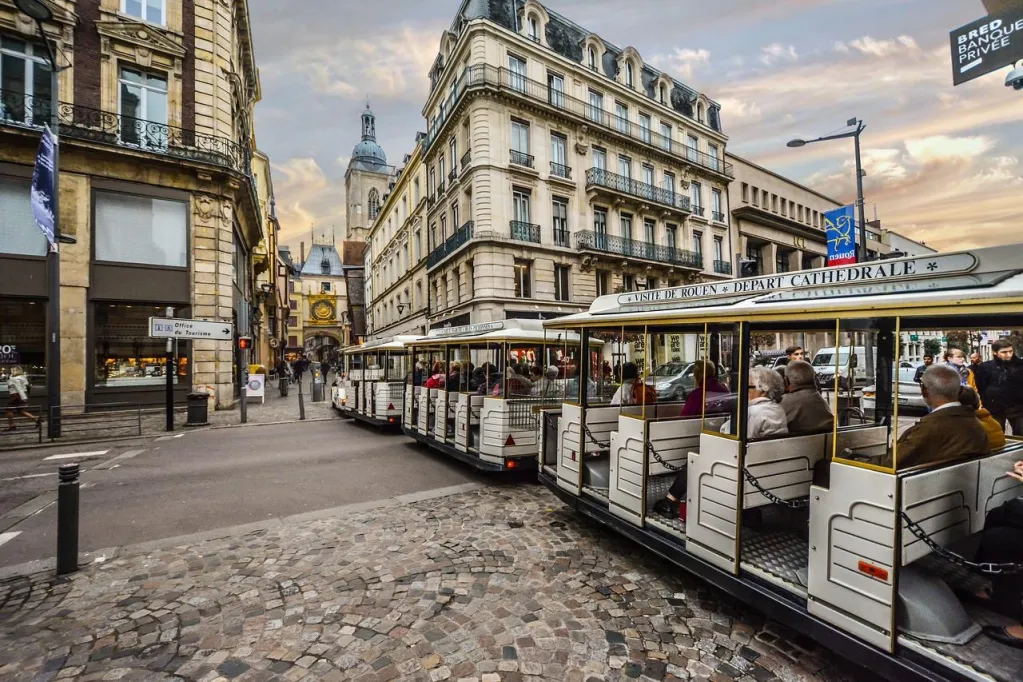
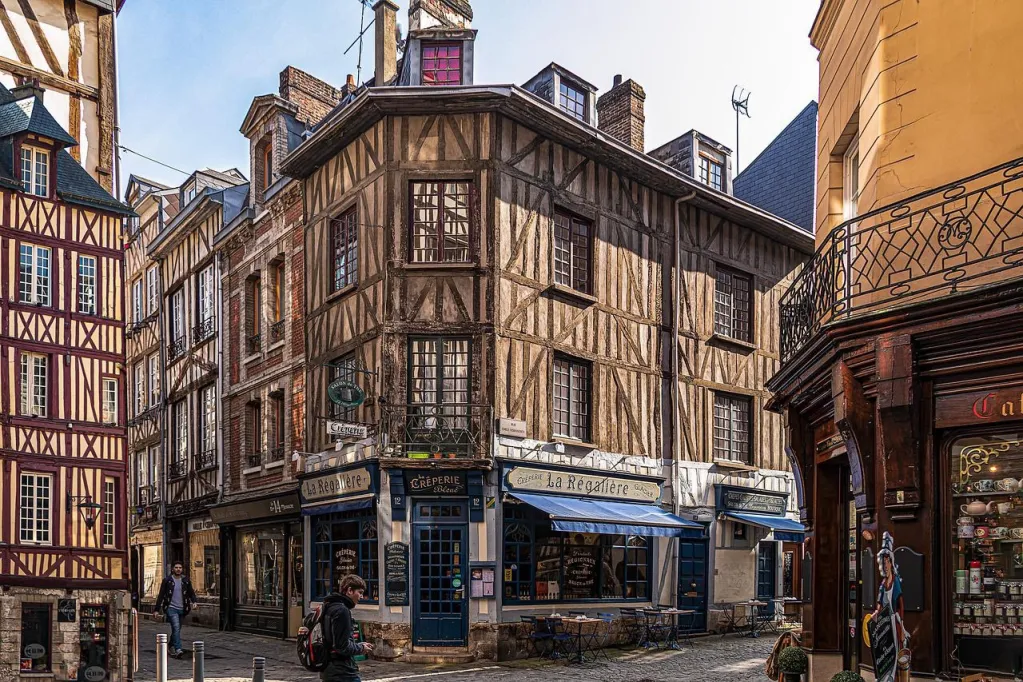
Our first visit was to a catholic church known simply as the ”Rouen Cathedral.” From start to finish, it took over eight hundred years to complete the construction of the Cathedral which is famous for its three towers—each in a different style. Given the length of time it took to complete the cathedral, it should not be surprising that the architectural influences overlapped three eras– the Early Gothic, the late Flamboyant and finally the Renaissance. Additionally, this church served as the subject of multiple impressionist paintings by Claude Monet, thereby earning its place in art history books.
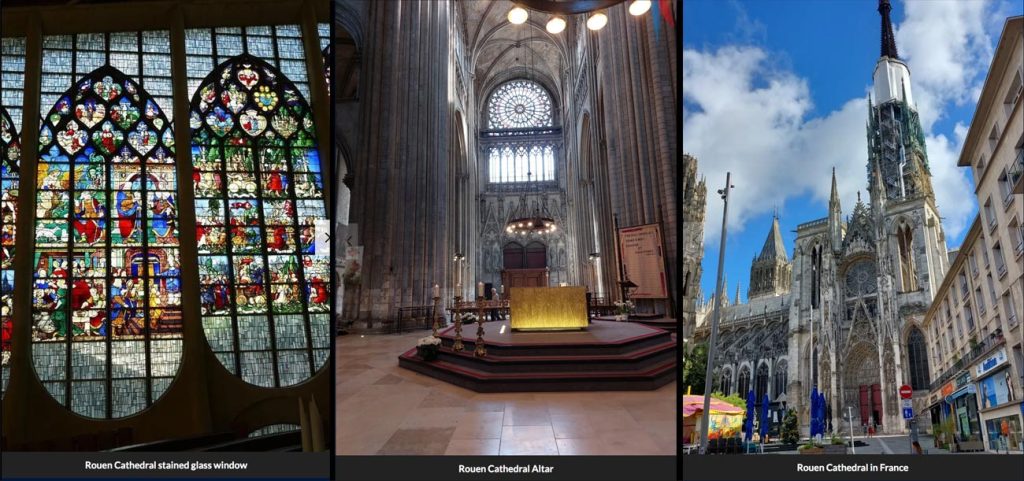
We then took a short walk through the streets of Rouen to the Rue du Gros-Horloge where we saw another notable landmark Rouen landmark–The Gros-Horloge (the large clock). Interestingly enough, construction of the astronomical clock began in 1389 by Jourdain de Leche, however, it was completed by Jean de Felain (who later became the first governor of the clock) when it was discovered del Leche lacked the expertise to complete the project.
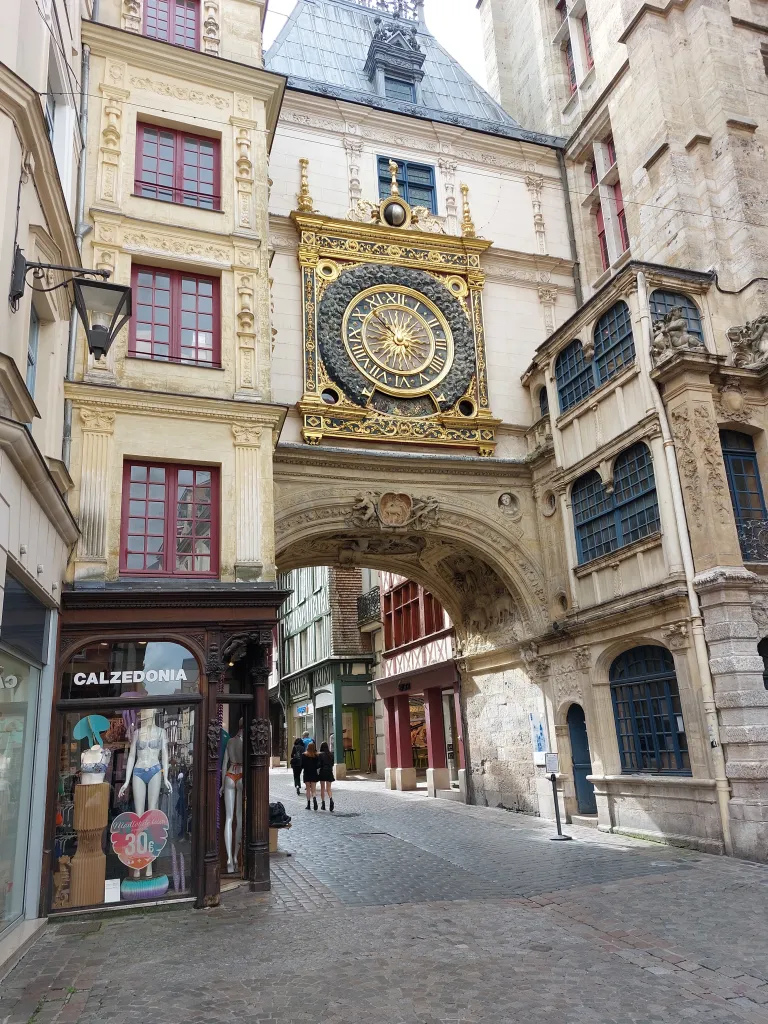
The clock was originally constructed without a dial, with one revolution of the hour-hand representing twenty-four hours. The Renaissance facade represents a golden sun with 24 rays on a starry blue background. The dial measures 2.5 metres in diameter. The phases of the moon are shown in the oculus of the upper part of the dial. It completes a full rotation in 29 days.
The clock has been in its current position since 1529, and a façade was added when they moved the piece. The mechanism was electrified in the 1920s and was restored in 1997.
Today, this clock remains the largest such devices in France—if not in the world.
Our final official stop in Rouen was ”Place du Vieux-Marché.“ Today it is a modern city center with restaurants, cafes, and shops along the street. However, the unique fact about this particular place is that it is located where Joan of Arc was burned at the stake for heresy in 1431. Commissioned in 1969 architect Louis Arretche completed the modern church of Saint Joan of Arc that stands there today in 1979. Unfortunately for some reason the inside of the church was closed to visitors when we were there, so we were unable to go in, but we were able to take some photos of the outside and of the statute.
Today, outside behind the church, there is a small garden named, Le Bouchet, which rests outside and to the north of the church marks the exact spot of the execution.
Below Church of Arc church and Joan of Arc statue
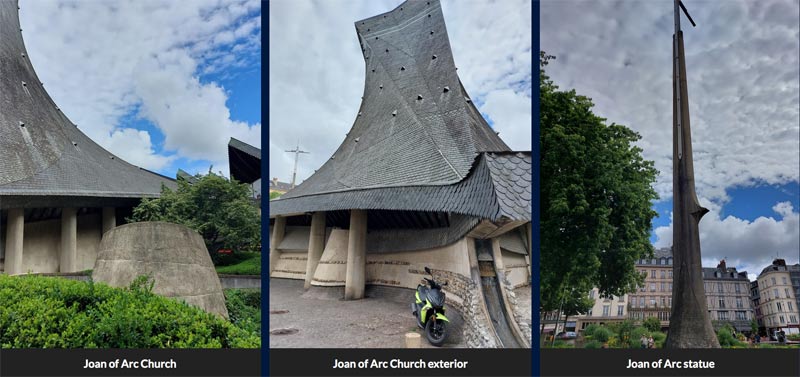
We had some free time where were walked along the streets, took some photos, shopped, and had coffee at one of the many restaurants and cafes along the area before getting back on the bus for the 75 kilometer ride to Honfleur
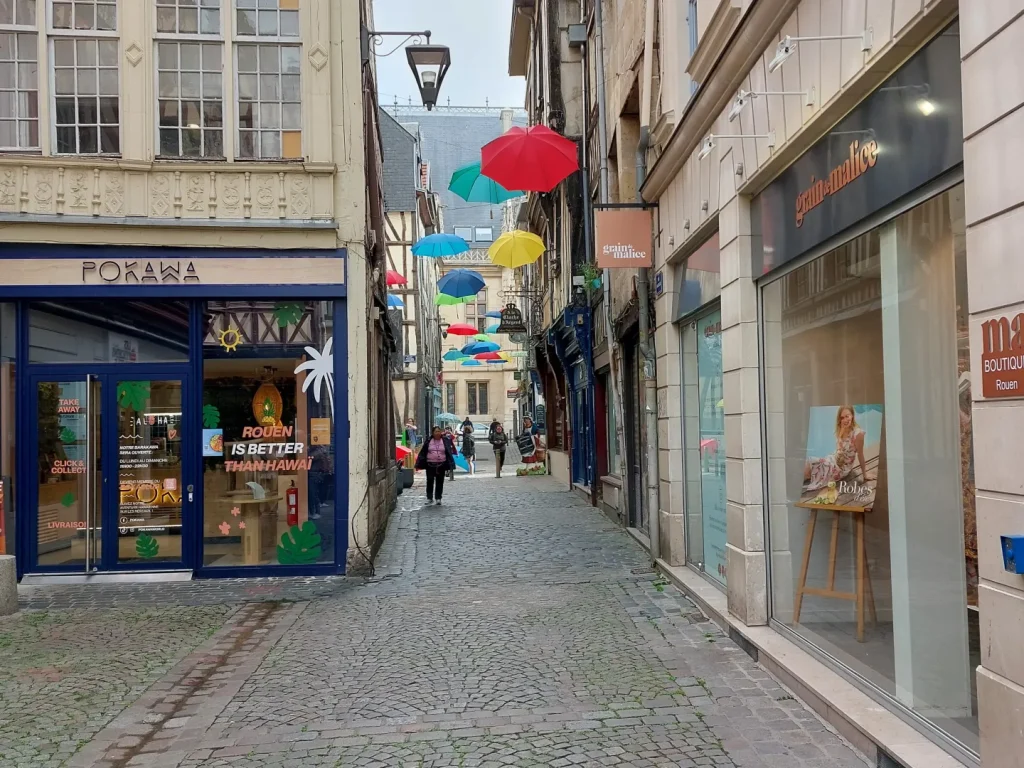
Honfleur streets
Located in Normandy Calvados region, Honfleur is on the estuary where the English Channel meets the Seine River. Perhaps the most notable thing about this charming city is the The Vieux-Bassin (old harbor), lined with 16th- to 18th-century townhouses—picturesque landscape which served as a source of inspiration for both Eugène Boudin and Claude Monet.
The city streets were lined with restaurants, shops, and numerous art galleries. Unfortunately, we were there during lunch time and all but one of the art galleries were closed, so we could not see too much of the local artists talent, but it appeared that the art galleries at least equalled the number of tourist gift shops in the town.
Brian and I stopped at a local restaurant where I ate the traditional French sandwich Croque Monsieur (grilled ham and cheese sandwich)—something I always eat at least once in every trip to France. See Croque Monsieur Recipe here.
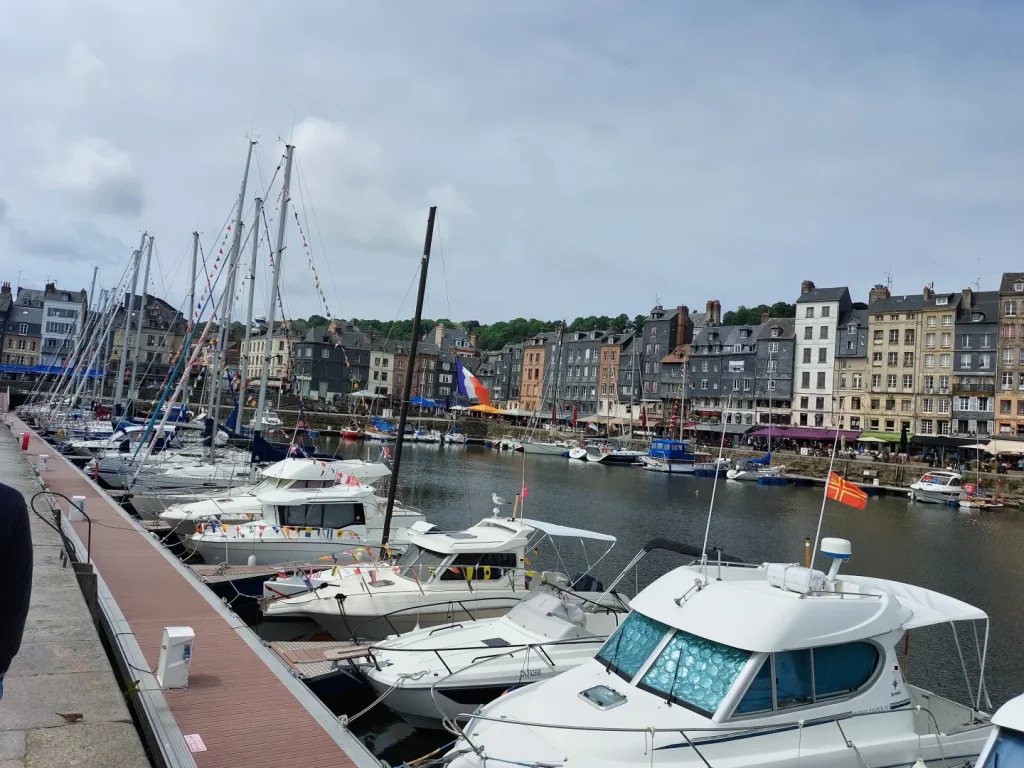
Honfleur dock, Normandy
We then boarded the bus and headed to Sainte- Honorine-des-Pertes, Saint-Laurent-sur-Mer, and Vierville-sur-Mer (also known as Omaha Beach or the American forces landing area during World War II). Omaha Beach was the codename for the areas along the Atlantic where the forces landed, but in actuality the names of the villages were described above. The 2,400 casualties suffered by U.S. forces (including those injured, missing in action and killed) were the worst of those suffered from the other D-Day beaches landings.
Today there is a beautiful monument and several statutes to honor those who lost their lives during this attack. One thing that is noteworthy about the area around the landing beaches is the sheer number of museums dedicated to the invasions. One could go to one museum per day for a month without going to the same one twice.
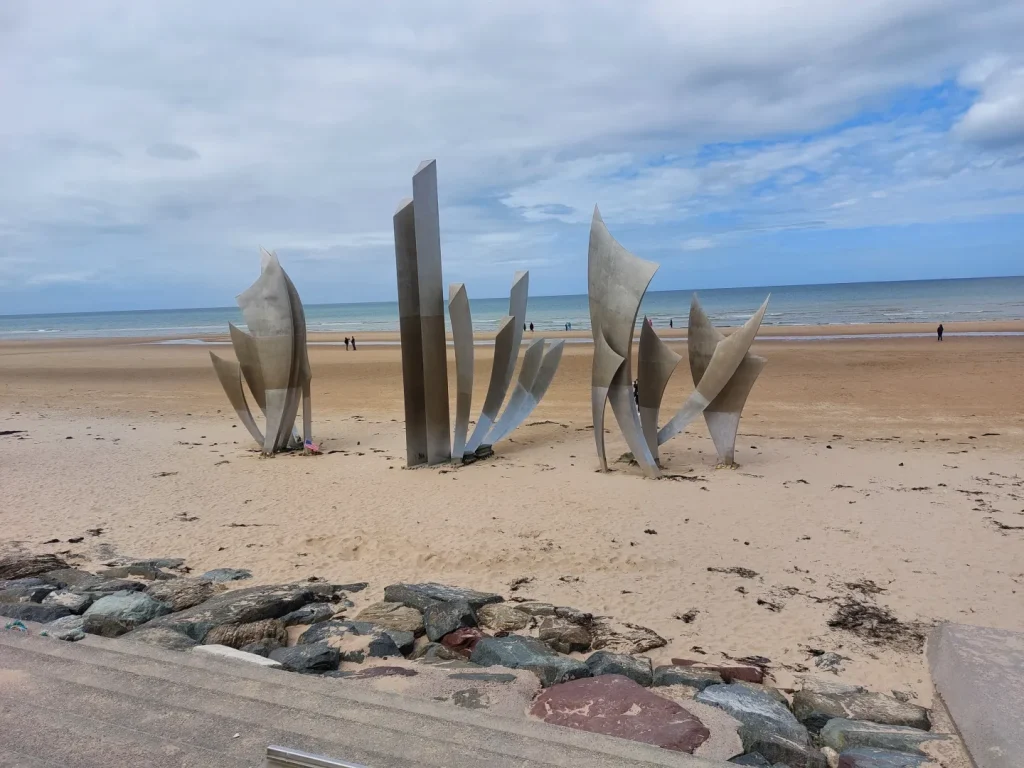
Omaha statue, Normandy
Regrettably, on this trip we only had ten minutes at Omaha Beach—just enough time to take a few pictures—hardly enough time to reflect appropriately on the sheer sacrifice and heroic measures of these soldiers, so I did not go into any of the museums on this trip. Despite the brief amount of time allotted, we did witness a group of musicians playing Taps on the bagpipes (which I have a short recording of) in front of the memorials.
Les Braves Omaha Beach Memorial
Here the meaning of the statute:
The monument Les Braves is located on the center of Omaha Beach.
The explanation of the monument stand on the boulevard of Omaha Beach.
Comment of the sculpteur:
I created this sculpture to honour the courage of these men:
Sons, husbands and fathers, who endangered and often sacrificed their lives in the hope of freeing the French people.
Les Braves consists of three elements:
The wings of Hope
So that the spirit which carried these men on June 6th, 1944 continues to inspire us, reminding us that together it is always possible to changing the future.
Rise, Freedom!
So that the example of those who rose against barbarity, helps us remain standing strong against all forms of inhumanity.
The Wings of Fraternity
So that this surge of brotherhood always reminds us of our responsibility towards others as well as ourselves.
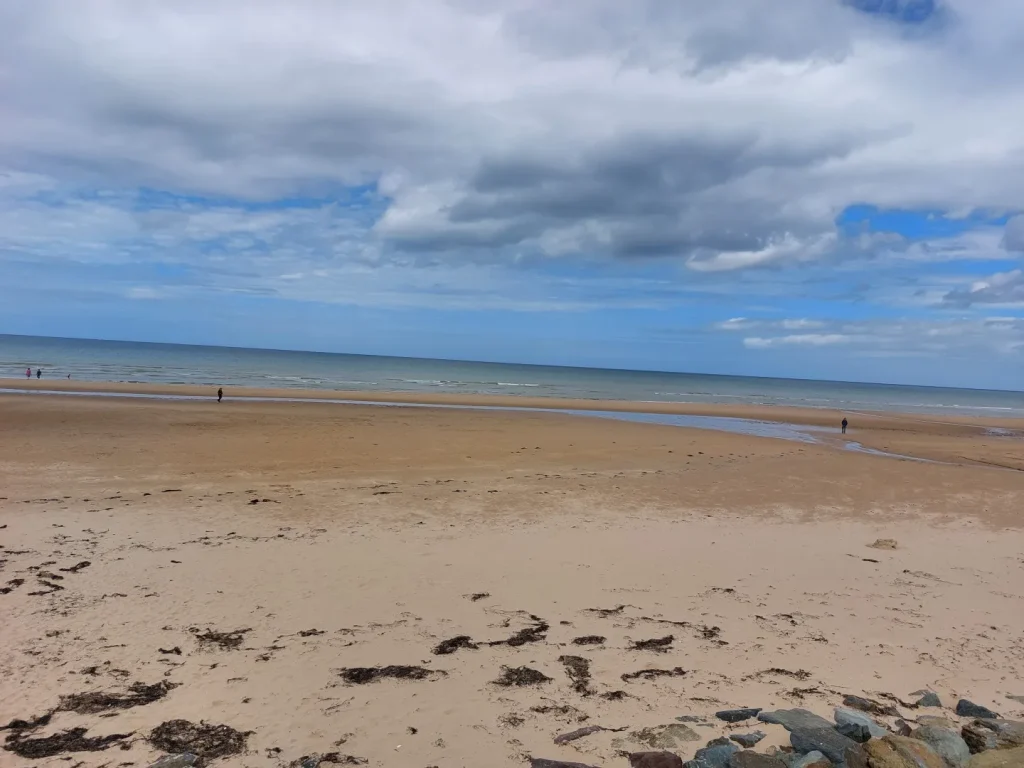
Omaha Beach, Normandy
Following the stop at the Omaha Beach memorial, we took the bus for approximately 20 minutes to the U.S. cemetery in Colleville-sur-Mer.
In addition to the 9,386 graves of American soldiers (most of whom died during the D-Day Landings) this enormous and meticulously well-maintained (by the U.S. government’s American Battle Monuments Commission) 172.5 acres memorial includes a chapel, reflection pool, a semicircular colonnade with a gallery at each end with maps chronicles of the military activities from the region.
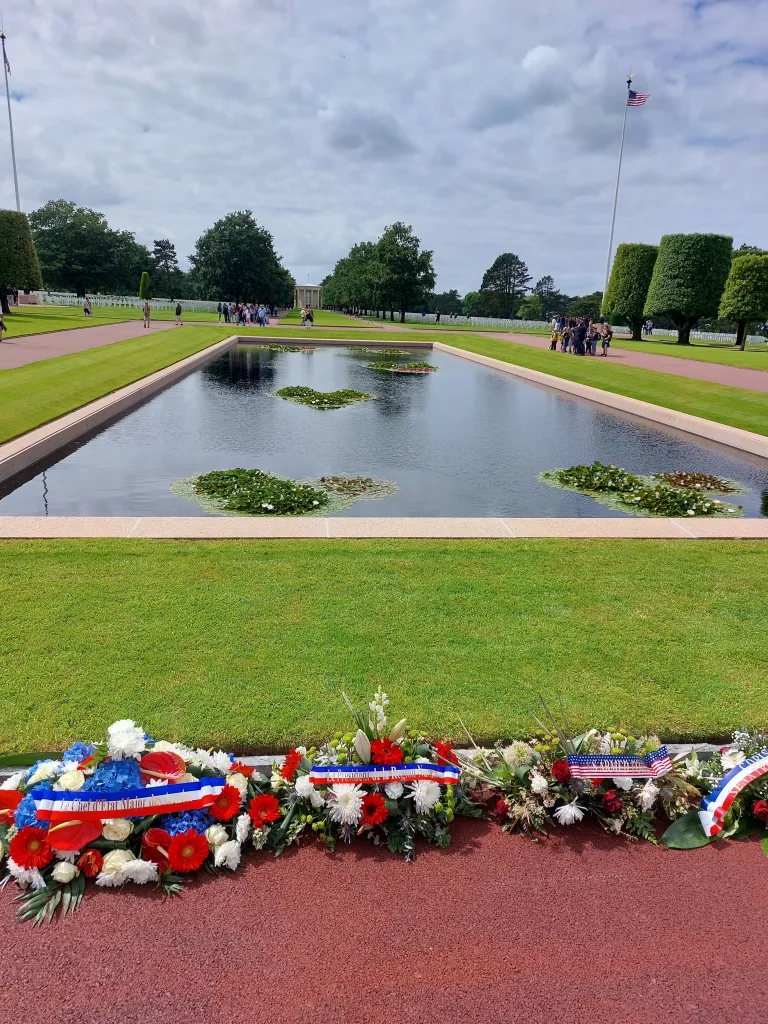
The Reflecting Pool at the Normandy American Cemetery and Memorial honors American soldiers who died in Europe during World War II
Read more here about the Normandy American Cemetery
Across from the reflection pool stands a bronze statue “Spirit of American Youth Rising from The Waves .” With over one million visitors annually, it remains one of the ABMC’s most visited cemetery.
One thing to note due to the high number for visitors, if people are interested in either wreath-laying ceremonies or special tours, they must request submit special permission to the cemetery staff—forms are available online.
American Cemetery, Normandy
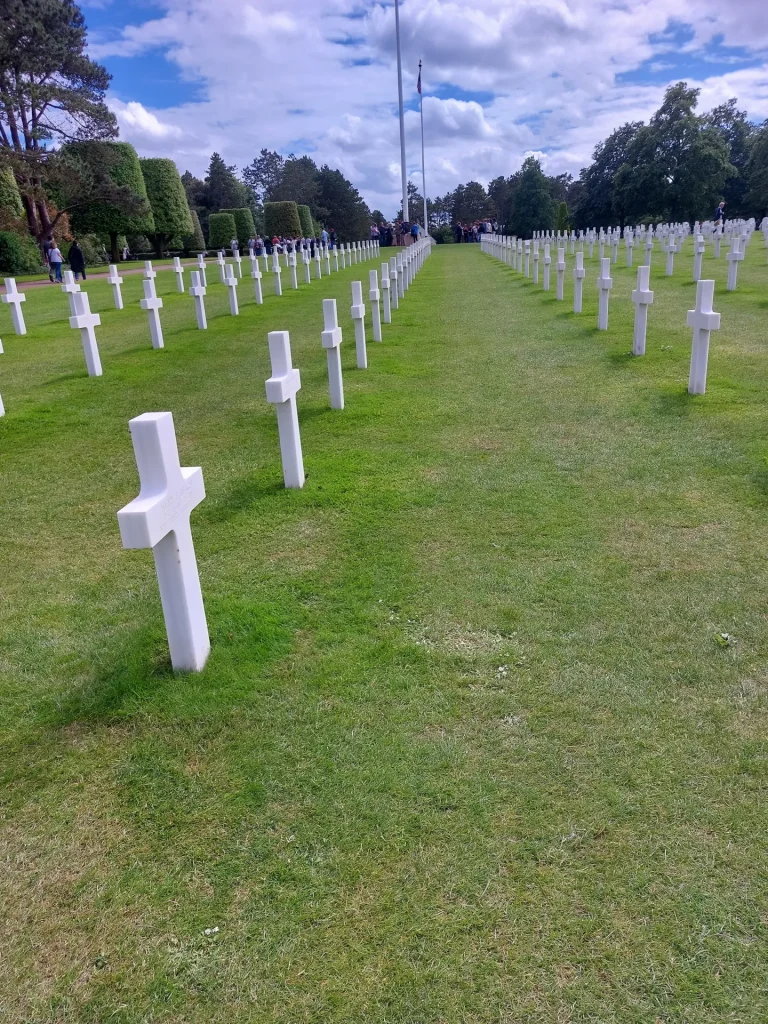
American Cemetery Statue, Normandy
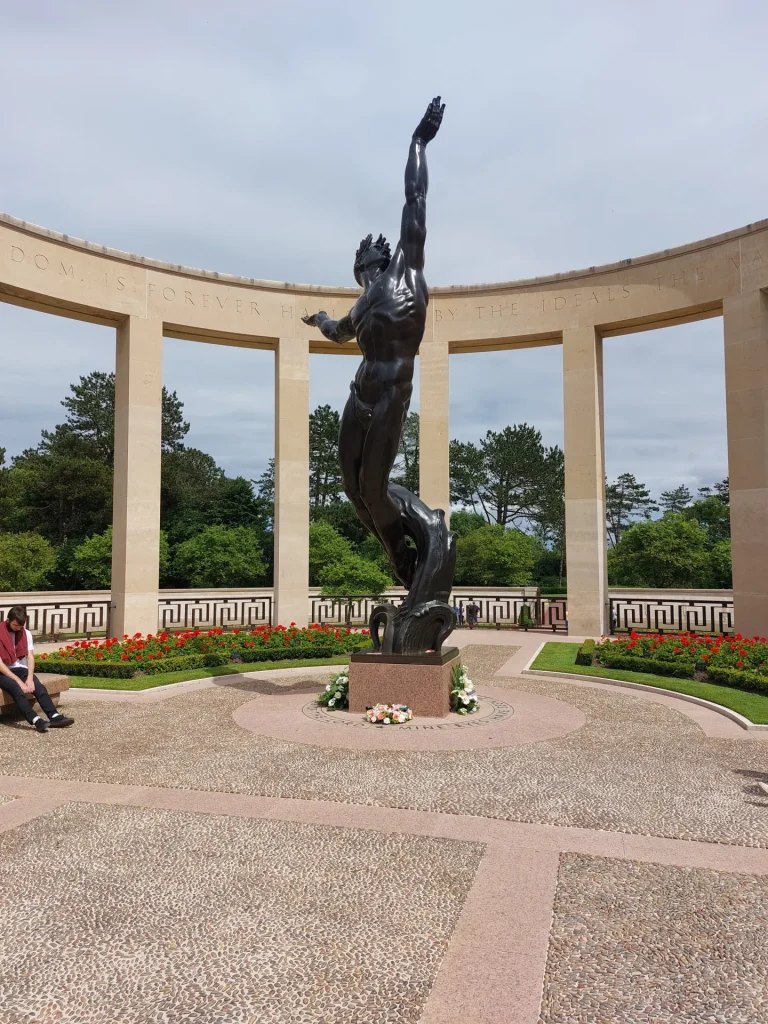
The Mont-Saint-Michel Abbey
After lunch on the second day of the tour, we headed to the world-famous Mont-Saint-Michel Abbey. The Abbey rests roughly 0.6 miles (or one kilometer) off the north-western coast of France and is near Avranches at the mouth of the Couesnon River covering 17 acres in area.
Over the years the commune has been used for many things—including a prison during the reign of Louis XI. Since 1862 the French government listed over sixty of the buildings within the community as “monuments historiques” and in 1979 UNESCO added Mont-Saint-Michel and its surrounding bay to its list of World Heritage Sites.
With over three million visitors annually at the Mont-Saint-Michel Abbey, the site is one of the France’s most frequently visited cultural sites.
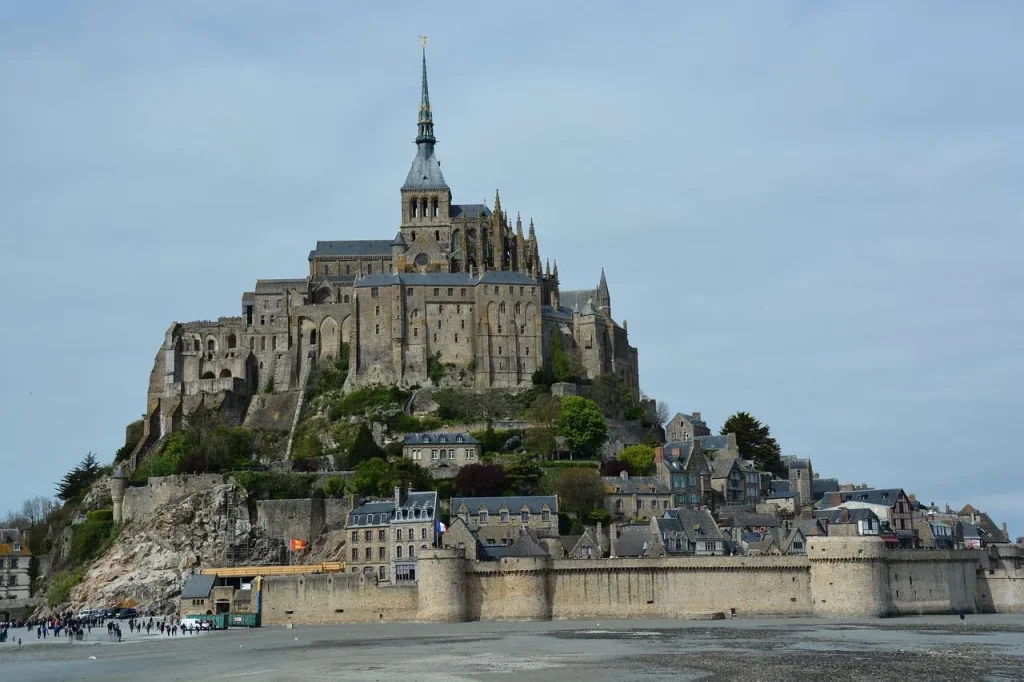
Mont-Saint-Michel Abbey, Normandy
When originally constructed, the abbey illustrated the structural composition of the town in a feudalist society—the top comprised of the monastery and abbey, followed by the next layer which consisted of great halls, followed by housing and stores on the next lower level, and outside the walls on the bottom one could find farmer and fisherman’s housing.
Today, the middle levels are filled with shops, and restaurants—typical of what one would expect to see in such a tourist site. For those adventurous enough to take a whopping 350 steps to the top, one can see the abbey which has been transformed into a museum (and a small portion which is used today as a monastery that remains closed to the public)
Impressions of Mont-Saint-Michel Abbey below:
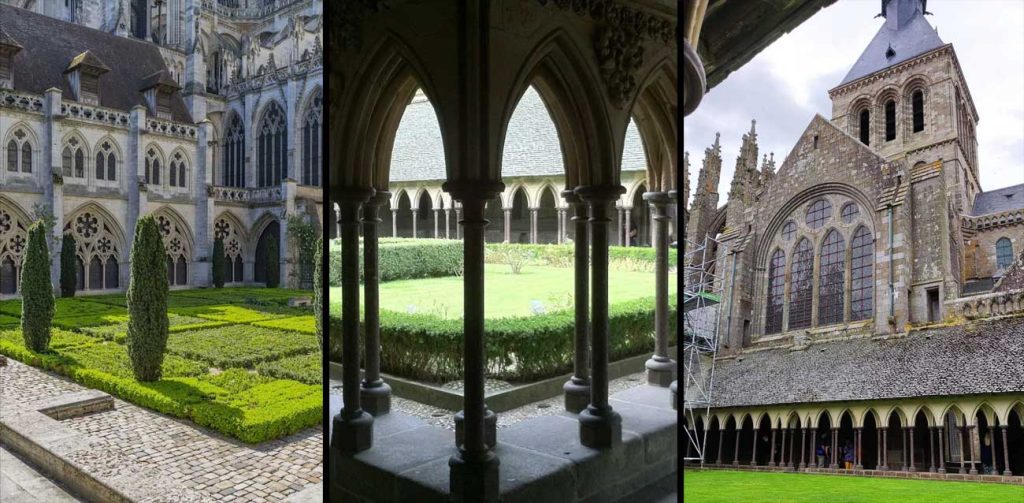
Because I hurt my ankle several years ago, climbing stairs, still a challenge for me, I regretfully stayed on the lower level while Brian and the rest of the group toured the Abbey. Although I did not make it to the top—there was still plenty to keep me busy while the others saw the museum.
I took a walk along the beach, admired the architecture of the community from various angles and walked in and out of many of the numerous shops extremely anxious to practice my French with the shopkeepers. I had known for several days there were going to be several steps involved should I decide to go all the way to the top, and I debated whether to attempt to go literally up to the minute I needed to decide.
I was disappointed I would not be able to make it this trip, but in the end, I figured risking injuring my ankle so badly that I would not be able to walk on it the rest of the trip was not worth the risk. Luckily, with all the shops, restaurants, and look out points there was plenty to do for me to still feel as if I experienced St. Michel, and luckily Brian took enough photos that I felt as if I had been there and witnessed everything myself.
So, if I can offer any words of wisdom to people who are interested in going but are intimidated by the stairs—GO ANYWAY. You will not be disappointed. In all my travels, this has been one of the most beautiful places I have ever encountered—albeit a bit touristy. However, Brian and I often always say, there is a reason so many places acquire the “tourist trap” definition to them, and there is absolutely nothing wrong with visiting these destinations when you come across them on your travels.
One of the main reasons Brian and I made the decision to move to Germany in 2017 is because we wanted to see more of Europe than Berlin or Paris. Since we have been here, this is our third trip to France, and two of the three times we ventured outside of Paris to see a different part of France. As with our 2020 trip to the French Alps, this trip to Northern France did not disappoint. I am already counting the days to our next trip to France—the French Riviera in September, Au revoir France, À bientôt
A word about the French Culture
One of the very first things I remember hearing from everyone from my French teachers to other Americans and some Germans, to even my own mother who had lived in Normandy for many years, was that the French are rude, they hate Americans, and they refuse to speak English. I would like to dispel this myth completely. I found the French I encountered to be friendly, patient, and considerate. They offered to speak English when I couldn’t remember the French, or they waited patiently when I told them I wanted to speak French. They smiled knowingly as I often had 2 or 3 languages come out of my mouth in one sentence, and nodded appreciatively as I stated that I was fluent in French living in Germany, the languages were blurred. I am not sure if it is because they knew I spoke the language, or the stereotypes are outdated, but I would like to firmly state that based on my recent experience, the reputation the French have had over the years is unfounded.
One of the main reasons my mother left France and returned to the states is because she did not feel as if she fit in with the French and the French culture–despite her fluency in the language. After the recent experiences I have had there, I wonder, if the my mother had known the French of today whether she would have in fact left France.
 About the Author:
About the Author:
Claudia Clark is a published author, speaker, and activist focused on social justice and democracy. In 2017, Clark and her husband moved from California to Germany, where she served as the national Get Out the Vote (GOTV) coordinator for the Democrats Abroad Germany chapter from January 2019 to May 2020.
Claudia Clark has several advanced degrees, with a focus on social work, women’s history, and labor. She currently lives in Berlin, where she is conducting research for her next book about the rise of the alt-right in Europe.
Her book about the Extraordinary Partnership of Barack Obama and Angela Merkel “Dear Barrack” can be ordered here on Amazon:



Recent Comments